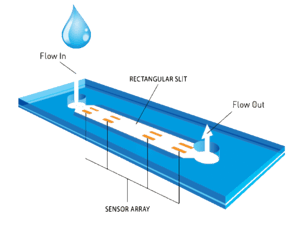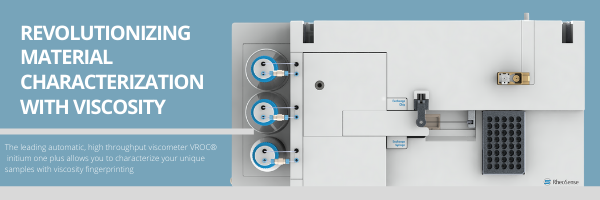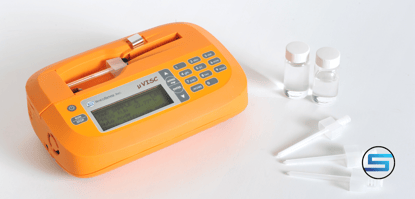Things generally are not created as a "one size fits all". Imagine the different tools you use when cooking. You have a full set of tools and utensils to use each with a specific function. While we can use one tool to complete multiple tasks, most of us would not use our butter knife to try and cut through a steak, nor would we use a meat cleaver to butter our bread. This same ideology applies to the world of rheology.
Rheology is a branch of physics dealing with the deformation and flow of materials. Rheology, in general, is a very broad subject and there are hundreds of instruments on the market today to help collect rheological data, measurements and calculations. With so many options to choose from, you may find yourself asking: "How do I know what instrument is right for my applications?".
While rheology is the flow of materials, RheoSense VROC® technology is focused on the rheology of fluids - specifically the flow of fluids, or viscosity. If your applications require you measure the storage and lost modulus or G' and G", VROC technology would not be right for you, as it is designed for the specific applications of steady shear and extensional viscosity measurements.

When determining what instrument is best for measuring your samples and collecting data relevant to your applications, you should first look at the problems you are trying to solve as well as the materials you are working with to develop questions you can ask to help select the appropriate viscometer for you.
When looking at the samples you are measuring, we encourage you to consider the following parameters to help ensure the instruments you are utilizing will achieve accurate, high quality data.
Sample Details
- Viscosity Range - While it is not necessary to know the exact viscosity, it is important to consider the viscosity range for the sample. The viscosity of water is orders of magnitude different than honey, and having an understanding of the viscosity range for your sample will ensure you are selecting an instrument capable of measuring that viscosity range.

- Newtonian or non-Newtonian - Depending on their viscosity behavior as a function of shear rate, stress, deformation history, fluids are characterized as Newtonian or non-Newtonian. Fluid flow is highly dependent on the viscosity of fluids. Successful characterization of viscosity is key in determining if a fluid is Newtonian or non-Newtonian, and what range of shear rates needs to be considered for a specific application.
- Yield Stress/ thixotropy - In contrast to Newtonian fluids, non-Newtonian fluids display either a non-linear relation between shear stress and shear rate, have a yield stress, or viscosity that is dependent on time or deformation history. When considering your sample, think about if it is solid up until a particular stress, after which it starts to flow or if it displays thixotropic behavior - time dependence after shearing for the structure to rebuild.
- Sample stability - Another important factor to consider is your sample stability. Does shearing impact your sample and do your samples age or degrade over time without any external forces?

- Sample volume- When determining the best instrument for your measurements you want to have a firm understanding of the volume of sample you have available for testing. VROC instruments requires a minimum of 26µL needed for testing (with an average sample testing size in the ~hundred µL range), whereas other instruments such as a rotational viscometer or a capillary tube require tens of mL of sample. It is crucial to have the sample volume available that is required by the instrument for testing.
- Sample recovery - Is your sample a precious sample, or do you need to test it in a different capacity after it has been exposed to shearing? If so, sample recovery capabilities will be necessary for the instrument you select for your viscosity measurements
- Microfluidics - When considering microfluidics, it is also important to understand and account for the composition of your sample.
- Particles, aggregates, droplet size and rigidity - it's important to consider particle size in the case of an emulsion, both how large and rigid they are.
- Length scale of phase separation or inhomogeneity
- Solubility - what is the sample components solubility? To achieve quality data and maintain your instrument, in microfluidics, it is important to clean your system well, which requires an understanding of what is in your samples and what solvent would provide the most effective method of cleaning.
- Does your sample contain film forming properties? Some formulations are designed to form films. Primarily related to the cleaning of microfluidics, it is essential to understand the best methods and solvents to use to flush the system to remove films to maintain the instrument and continue to achieve quality data.
Once you have determined the details of the sample(s) you will be measuring, the next consideration to take into account are your measurement goals, or what you want to achieve in measuring the viscosity of your sample.
Measurement Goals
- Quality control or quick screen - Viscosity is a valuable measurement parameter and it is often beneficial to run a thorough analysis and characterization, however sometimes all you need is a quick quality control or screening method to monitor a specific process
- Predict specific performance properties - Some measurement goals are focused around trying to predict specific performance properties. This is most common in formulation or development when you need to know how a sample will perform in a real-life application based on a parameter.
- Throughput sample characterization/ exploration - Some people use viscosity as a less practical and more investigative tool. This can include a through characterization and exploration of their sample and modeling their data to extract some specific parameters about their samples.
Once you have determined your measurements goals you want to focus on what testing parameters are relevant to achieve those goals.
- Quick screen - Typically it is adequate to establish a single point type measurement, however when choosing shear rate and temperature you want to maximize the differentiation that you are trying to identify.
- Performance Predictions - When working to predict how a particular sample will perform for your specific applications you want to estimate the most practical or realistic shear (or extensional) rates that can be extracted from your measurements. It is also important to consider all storage and application temperatures relevant to your sample and the common conditions you are trying to simulate in your testing. This include processing conditions and temperatures as well. When considering performance predictions it is also important to consider the effects of time on your samples and applications and should be applied to your measurements. This can relate to both time and degradation under shear when running your measurements.
- Sample Characterization - When your measurement goals are thorough sample characterization or exploration it is important to consider a broad range of measurement parameters - including shear rates and/ or temperatures - to help quantify data across the full spectrum. It can also be important to characterize intrinsic viscosity which involves looking at a dilute concentration series with your samples to quantify
Once you have a good idea of what your goals are and the composition of your samples you should be able to narrow down a range of testing parameters that will achieve the data you need for your applications.
When considering what tool is best for your applications it is most important to consider the sample specifications, composition, instrument compatibility, measurement goals and parameters. However, there are other important considerations to keep in mind in regards to operating costs and time to complete your measurements and analyze your data.
Other important considerations
- Automation and high throughput - Automation is intended to reduce cost, improve production quality, increase production speed, reduce down time, and free up experts time for your most valuable work. When designing an instrument to automate viscosity measurements we thought of what is most important to our customers - increased productivity, decreased time to market and increased return on investment (ROI). The VROC® initium one plus creates a tremendous amount of data with minimal volume and includes an intuitive software that allows automatic testing of samples on 96 well plate or a 40 vial rack runs,. With this automation you can "set and forget" your viscosity measurements, greatly increasing efficiency and allowing your end users to do higher value activities.

- Portability - When thinking of on-site testing or other examples such as the quick screen portability may be a key consideration when choosing an instrument. The microVISC small sample, portable viscometer is small enough to fit into a glovebox and can be easily transported from room to room in a laboratory, or even from site to site for viscosity measurements.

- Sample retrieval and recovery - The RheoSense VROC initium one plus features sample retrieval and recovery. Retrieval allows for unlimited testing on the same sample while recovery provided the ability to do orthogonal testing on a sample with known history. With recoverable samples, you are able to take testing a step further and investigate shear impact on proteins.
At the 2021 Fall Viscosity Summit, RheoSense Principal Scientist, Dr. Stacey Elliott, shared how to select the best viscometer for your applications. Watch the full session recording of Dr. Elliott's presentations to learn more about how to select the right viscometer for your applications including examples of common applications and case studies.
Want to speak with one of our rheology experts to determine what viscometer is best for your applications? Contact us to schedule a free consultation and our experts can discuss with you what solution will give you the best ROI and the most accurate results!
Written by: Eden Reid, RheoSense Senior Marketing and Sales Operations


